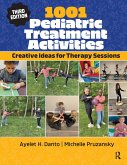Marilyn B. Cole
Group Dynamics in Occupational Therapy (eBook, PDF)
The Theoretical Basis and Practice Application of Group Intervention
79,95 €
79,95 €
inkl. MwSt.
Sofort per Download lieferbar

40 °P sammeln
79,95 €
Als Download kaufen

79,95 €
inkl. MwSt.
Sofort per Download lieferbar

40 °P sammeln
Jetzt verschenken
Alle Infos zum eBook verschenken
79,95 €
inkl. MwSt.
Sofort per Download lieferbar
Alle Infos zum eBook verschenken

40 °P sammeln
Marilyn B. Cole
Group Dynamics in Occupational Therapy (eBook, PDF)
The Theoretical Basis and Practice Application of Group Intervention
- Format: PDF
- Merkliste
- Auf die Merkliste
- Bewerten Bewerten
- Teilen
- Produkt teilen
- Produkterinnerung
- Produkterinnerung

Bitte loggen Sie sich zunächst in Ihr Kundenkonto ein oder registrieren Sie sich bei
bücher.de, um das eBook-Abo tolino select nutzen zu können.
Hier können Sie sich einloggen
Hier können Sie sich einloggen
Sie sind bereits eingeloggt. Klicken Sie auf 2. tolino select Abo, um fortzufahren.

Bitte loggen Sie sich zunächst in Ihr Kundenkonto ein oder registrieren Sie sich bei bücher.de, um das eBook-Abo tolino select nutzen zu können.
In occupational therapy practice, well designed groups represent social and cultural contexts for occupational performance in everyday life. Group Dynamics in Occupational Therapy: The Theoretical Basis and Practice Application of Group Intervention , the best-selling text for over 25 years by Marilyn B.
- Geräte: PC
- ohne Kopierschutz
- eBook Hilfe
- Größe: 14.04MB
Andere Kunden interessierten sich auch für
![Group Dynamics in Occupational Therapy (eBook, ePUB) Group Dynamics in Occupational Therapy (eBook, ePUB)]() Marilyn B. ColeGroup Dynamics in Occupational Therapy (eBook, ePUB)79,95 €
Marilyn B. ColeGroup Dynamics in Occupational Therapy (eBook, ePUB)79,95 €![Occupational and Activity Analysis (eBook, PDF) Occupational and Activity Analysis (eBook, PDF)]() Heather ThomasOccupational and Activity Analysis (eBook, PDF)66,95 €
Heather ThomasOccupational and Activity Analysis (eBook, PDF)66,95 €![Kinesiology for Occupational Therapy (eBook, PDF) Kinesiology for Occupational Therapy (eBook, PDF)]() Melinda RybskiKinesiology for Occupational Therapy (eBook, PDF)86,95 €
Melinda RybskiKinesiology for Occupational Therapy (eBook, PDF)86,95 €![Professionalism Across Occupational Therapy Practice (eBook, PDF) Professionalism Across Occupational Therapy Practice (eBook, PDF)]() Elizabeth DeiuliisProfessionalism Across Occupational Therapy Practice (eBook, PDF)60,95 €
Elizabeth DeiuliisProfessionalism Across Occupational Therapy Practice (eBook, PDF)60,95 €![Applied Theories in Occupational Therapy (eBook, PDF) Applied Theories in Occupational Therapy (eBook, PDF)]() Marilyn B. ColeApplied Theories in Occupational Therapy (eBook, PDF)63,95 €
Marilyn B. ColeApplied Theories in Occupational Therapy (eBook, PDF)63,95 €![An Occupational Perspective on Leadership (eBook, PDF) An Occupational Perspective on Leadership (eBook, PDF)]() Sandra DunbarAn Occupational Perspective on Leadership (eBook, PDF)60,95 €
Sandra DunbarAn Occupational Perspective on Leadership (eBook, PDF)60,95 €![1001 Pediatric Treatment Activities (eBook, PDF) 1001 Pediatric Treatment Activities (eBook, PDF)]() Ayelet Danto1001 Pediatric Treatment Activities (eBook, PDF)60,95 €
Ayelet Danto1001 Pediatric Treatment Activities (eBook, PDF)60,95 €-
-
-
In occupational therapy practice, well designed groups represent social and cultural contexts for occupational performance in everyday life. Group Dynamics in Occupational Therapy: The Theoretical Basis and Practice Application of Group Intervention, the best-selling text for over 25 years by Marilyn B.
Dieser Download kann aus rechtlichen Gründen nur mit Rechnungsadresse in A, B, BG, CY, CZ, D, DK, EW, E, FIN, F, GR, HR, H, IRL, I, LT, L, LR, M, NL, PL, P, R, S, SLO, SK ausgeliefert werden.
Produktdetails
- Produktdetails
- Verlag: Taylor & Francis eBooks
- Seitenzahl: 464
- Erscheinungstermin: 1. Juni 2024
- Englisch
- ISBN-13: 9781040143810
- Artikelnr.: 70884040
- Verlag: Taylor & Francis eBooks
- Seitenzahl: 464
- Erscheinungstermin: 1. Juni 2024
- Englisch
- ISBN-13: 9781040143810
- Artikelnr.: 70884040
- Herstellerkennzeichnung Die Herstellerinformationen sind derzeit nicht verfügbar.
Marilyn B. (Marli) Cole, MS, OTR/L, FAOTA, is a Professor Emeritus of Occupational Therapy at Quinnipiac University, Hamden, Connecticut, and an occupational therapy consultant. After 25 years of teaching she has now become a full-time writer. She holds a bachelor's degree in English from the University of Connecticut, a graduate certificate in occupational therapy from the University of Pennsylvania, and a master's degree in clinical psychology from the University of Bridgeport. Also, she is licensed by the state of Connecticut to practice occupational therapy and is certified by the Center for Study of Sensory Integrative Dysfunction to administer the Southern California Sensory Integration Tests. The author has more than 24 years of practice experience in mental health, pediatrics, and geriatrics. Places of work include Eastern Pennsylvania Psychiatric Institute in Philadelphia, Pennsylvania, and Middlesex Memorial Hospital in Middletown, Lawrence and Memorial Hospital in New London, and Newington Children's Hospital, all in Connecticut. While teaching, courses included psychiatric clinical media, group leadership, group dynamics, frames of reference, fieldwork I and II, psychopathology, sensorimotor integration, computer technology lab, evaluation, intervention, problem-based learning, research, and geriatrics. She has also served as consultant for the West Haven VA Medical Center, the Portland Public Schools, Fairfield Hills Hospital, the Institute of Living, St. Joseph's Manor, and Baldwin Senior Center, all in Connecticut. In conjunction with Quinnipiac University, she escorted groups of fieldwork students to clinical and community practice sites in England, Costa Rica, and Australia. In addition to four prior editions of Group Dynamics in Occupational Therapy: The Theoretical Basis and Practice Application of Group Intervention (1993, 1998, 2005, 2012), Marli has coauthored three books within the past 10 years: Applied Theories in Occupational Therapy: A Practical Approach (2008), with coauthor Roseanna Tufano of Quinnipiac University; Social Participation in Occupational Contexts: In Schools, Clinics and Communities (2011), with coauthor Mary Donohue, retired professor from New York University; and Productive Aging: An Occupational Perspective (2015), with coauthor Karen Macdonald. A coedited book with Jennifer Creek, an occupational therapy researcher and writer from York, England, entitled Global Perspectives in Professional Reasoning, was published by SLACK Incorporated in 2016. Her chapters for other texts include "A Preference for Activity" in Gibson's Group Process and Structure (1988); "Client-Centered Groups" in Creek and Lougher's Occupational Therapy in Mental Health (2008, 2015); "Retirement, Volunteering, and End of Life Issues" in Meriano and Latella's Occupational Therapy Interventions (2007, 2016); "Theories of Aging" in Coppola, Elliott, and Toto's Strategies to Advance Gerontology Excellence (2008); and "Theory Development" in Jacobs and MacRae's Occupational Therapy Essentials for Clinical Competence, Third Edition (2017). Marli is currently working on a grant to study self-management for lower back pain, and has enjoyed presenting results of her productive aging study with coauthor Karen Macdonald. She and her husband, Marty, love sailing, snorkeling, and traveling, especially cruises. They are at home in Stratford, Connecticut, and Freeport, Bahamas.
About the AuthorIntroduction to the Fifth EditionIntroduction to the Fourth Edition Section I Acquiring Group Skills Chapter 1 Group Leadership: Cole's Seven Steps Chapter 2 Understanding Group Dynamics Chapter 3 Client-Centered Groups Chapter 4 Groups and the Occupational Therapy Practice Framework: Domain and Process, Third Edition Section II Group Guidelines From Selected Frames of Reference and Models Chapter 5 Psychodynamic Approaches Chapter 6 The Behavioral Cognitive Continuum Chapter 7 Allen's Cognitive Disabilities Groups Chapter 8 Developmental Approaches Chapter 9 Sensorimotor Approaches Chapter 10 A Model of Human Occupation and Other Occupation-Based Models Section III Planning an Occupational Therapy Group Chapter 11 Writing a Group Protocol Chapter 12 A Group Laboratory Experience Chapter 13 A Group Experience: Developing Cultural Competence Chapter 14 Community Intervention: A Service Learning Experience for Students Chapter 15 Wellness, Recovery, and Trauma-Informed CareAppendix A The Task-Oriented Group as a Context for TreatmentGail S. Fidler, OTRAppendix B The Concept and Use of Developmental GroupsAnne Cronin Mosey, PhD, OTRAppendix C Summary of Mosey's Adaptive SkillsAppendix D Excerpts From the Occupational Therapy Practice Framework: Domain and Process, Third EditionAppendix E Theory-Based Group Leadership GuidelinesAppendix F Overview of the International Classification of Function, Disability and Health, Second Edition Index
About the AuthorIntroduction to the Fifth EditionIntroduction to the Fourth Edition Section I Acquiring Group Skills Chapter 1 Group Leadership: Cole's Seven Steps Chapter 2 Understanding Group Dynamics Chapter 3 Client-Centered Groups Chapter 4 Groups and the Occupational Therapy Practice Framework: Domain and Process, Third Edition Section II Group Guidelines From Selected Frames of Reference and Models Chapter 5 Psychodynamic Approaches Chapter 6 The Behavioral Cognitive Continuum Chapter 7 Allen's Cognitive Disabilities Groups Chapter 8 Developmental Approaches Chapter 9 Sensorimotor Approaches Chapter 10 A Model of Human Occupation and Other Occupation-Based Models Section III Planning an Occupational Therapy Group Chapter 11 Writing a Group Protocol Chapter 12 A Group Laboratory Experience Chapter 13 A Group Experience: Developing Cultural Competence Chapter 14 Community Intervention: A Service Learning Experience for Students Chapter 15 Wellness, Recovery, and Trauma-Informed CareAppendix A The Task-Oriented Group as a Context for TreatmentGail S. Fidler, OTRAppendix B The Concept and Use of Developmental GroupsAnne Cronin Mosey, PhD, OTRAppendix C Summary of Mosey's Adaptive SkillsAppendix D Excerpts From the Occupational Therapy Practice Framework: Domain and Process, Third EditionAppendix E Theory-Based Group Leadership GuidelinesAppendix F Overview of the International Classification of Function, Disability and Health, Second Edition Index
"The best aspect of the book is its descriptive application of group dynamic specifically applied to the five various models of practice. To read through the fifth edition is comforting, and the sections about wellness, recovery, and trauma-informed care are delightful, welcome, necessary additions."
- Janice D Hinds, MS, OTR/L, BCMH, Doody's Book Review Service
- Janice D Hinds, MS, OTR/L, BCMH, Doody's Book Review Service







